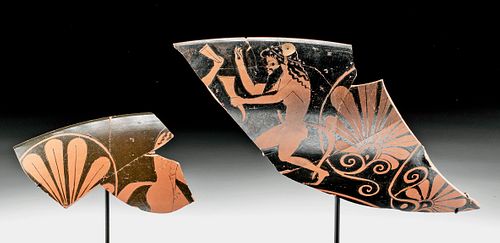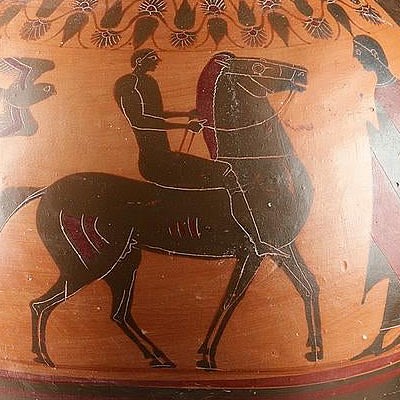Attic Red Figure Kylix Pottery Fragments, Oltos Painter
Lot 22f
About Seller
Artemis Fine Arts
686 S Taylor Ave, Ste 106
Louisville, CO 80027
United States
Selling antiquities, ancient and ethnographic art online since 1993, Artemis Gallery specializes in Classical Antiquities (Egyptian, Greek, Roman, Near Eastern), Asian, Pre-Columbian, African / Tribal / Oceanographic art. Our extensive inventory includes pottery, stone, metal, wood, glass and textil...Read more
Categories
Estimate:
$6,000 - $9,000
Absentee vs Live bid
Two ways to bid:
- Leave a max absentee bid and the platform will bid on your behalf up to your maximum bid during the live auction.
- Bid live during the auction and your bids will be submitted real-time to the auctioneer.
Bid Increments
| Price | Bid Increment |
|---|---|
| $0 | $25 |
| $300 | $50 |
| $1,000 | $100 |
| $2,000 | $250 |
| $5,000 | $500 |
| $10,000 | $1,000 |
| $20,000 | $2,500 |
| $50,000 | $5,000 |
| $100,000 | $10,000 |
| $200,000 | $20,000 |
About Auction
By Artemis Fine Arts
Jun 4, 2020
Set Reminder
2020-06-04 10:00:00
2020-06-04 10:00:00
America/New_York
Bidsquare
Bidsquare : Exceptional Antiquities, Asian, Ethnographic
https://www.bidsquare.com/auctions/artemis-gallery/exceptional-antiquities-asian-ethnographic-5185
An important one-day auction featuring museum-worthy examples of Egyptian, Greek, Roman, Etruscan, Near Eastern, Far East / Asian, Pre-Columbian, African / Tribal, Oceanic, Native American, Spanish Colonial, Russian, Fossils, Ancient Jewelry, Fine Art, so much more! Artemis Fine Arts info@artemisfinearts.com
An important one-day auction featuring museum-worthy examples of Egyptian, Greek, Roman, Etruscan, Near Eastern, Far East / Asian, Pre-Columbian, African / Tribal, Oceanic, Native American, Spanish Colonial, Russian, Fossils, Ancient Jewelry, Fine Art, so much more! Artemis Fine Arts info@artemisfinearts.com
- Lot Description
Ancient Greece, Athens (Attic), attributed to the Oltos Painter, ca. 525 to 500 BCE. Two Attic red-figure kylix fragments, the larger one depicting a bearded satyr in profile with an erect penis. He holds a drinking rhyton that is probably filled with wine for Dionysian festivities. A floral vine decorates the field. The smaller fragment shows part of a satyr's body (with tail) and a floral motif. Both fragments have been attributed to the Oltos Painter. For more about the Oltos Painter, see the biographical statement from the J. Paul Getty Museum in the extended description below. Size of largest: 8" W x 5.5" H (20.3 cm x 14 cm); 6.3" H (16 cm) on included custom stand.
According to the J. Paul Getty Museum, "As a vase-painter in Athens in the period from about 525 to 500 B.C., Oltos worked in red-figure in the early days of the technique. He also produced several bilingual cups with red-figure decoration on the exterior and black-figure on the interior, a type that was popular in this period. Although Oltos specialized in the decoration of cups, he produced a range of other shapes as well. Scholars have attributed over 150 surviving vases to him, but only two of these bear his signature. Throughout his long career, Oltos worked for at least six different potters, including the workshop of Nikosthenes and Pamphaios. As a painter, Oltos emphasized elegance in his figures over naturalism. His favorite subjects were scenes of revelry and mythological scenes of heroes."
Provenance: private Connecticut, USA collection; ex P. Sharrer, New Jersey, USA; ex A.S. Richter collection, California, USA acquired from the above, 6 March 1990.
All items legal to buy/sell under U.S. Statute covering cultural patrimony Code 2600, CHAPTER 14, and are guaranteed to be as described or your money back.
A Certificate of Authenticity will accompany all winning bids.
We ship worldwide and handle all shipping in-house for your convenience.
#155933Both are fragments, expertly repaired with no added material or overpainting from a few large pieces. Surfaces are slightly abraded with a few tiny chips. Slight fading to pigment on the larger. Motifs are very clear and well preserved.Condition
- Shipping Info
-
All shipping is handled in-house for your convenience. Your invoice from Artemis Gallery will include shipping calculation instructions. If in doubt, please inquire BEFORE bidding for estimated shipping costs for individual items.
-
- Buyer's Premium



 EUR
EUR CAD
CAD AUD
AUD GBP
GBP MXN
MXN HKD
HKD CNY
CNY MYR
MYR SEK
SEK SGD
SGD CHF
CHF THB
THB













